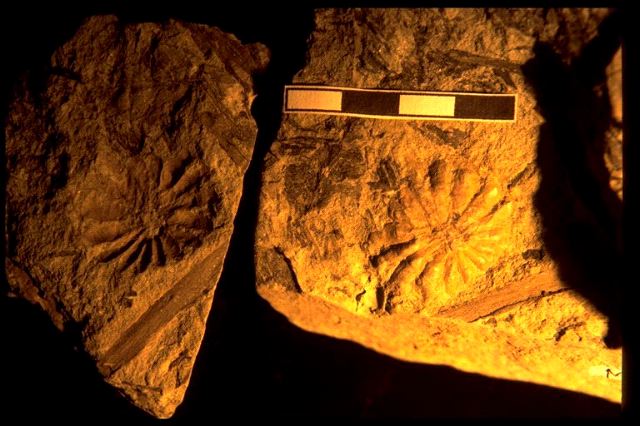Trace fossils
Fossils of aquatic invertebrates are rather rare in the Escuminac Formation.
 (60 kb) Traces left in the sediments by bottom-dwelling organisms, however, demonstrate that a greater variety of invertebrate animals were present than the fossil record might otherwise suggest.
(60 kb) Traces left in the sediments by bottom-dwelling organisms, however, demonstrate that a greater variety of invertebrate animals were present than the fossil record might otherwise suggest.
These traces are known as ichnofossils and are the result of animal activity preserved in sedimentary rock. The most common types are tracks, trails, burrows and borings.
Ichnologists – trace fossil specialists – are responsible for naming ichnofossils. Because it is difficult to know which animal left what trace, these names do not reflect the species that made them. The terminology is arbitrary, seeing as the same animal could have left different traces, just as similar traces could be the work of different animals. Two types of ichnofossils are found at Miguasha.
Gyrophyllites are shaped like small daisies lying flat on the sand. Spreading outward from a central point, each “petal” is 1 to 2 cm long, increasing in width from 0.5 mm at the centre to 6 mm at the tip. Up to 18 of these petals may be discerned in the structure. Perhaps a small worm-like animal living in a vertical burrow pushed its body out one or two centimetres to find something to eat before shrinking back into its den. With each forage in a different direction, its actions created a radial pattern.
Planolites is the other type of ichnofossil. These traces resemble the marks that a small worm leaves behind as it moves aimlessly over the substratum. The marks are 2 to 3 mm wide, sometimes straight, sometimes meandering.
Both types of ichnofossils indicate a marine environment when found in sedimentary formations elsewhere. Despite being relatively rare in the Escuminac Formation, they do demonstrate that the area experienced some marine influence.

 (60 kb) Traces left in the sediments by bottom-dwelling organisms, however, demonstrate that a greater variety of invertebrate animals were present than the fossil record might otherwise suggest.
(60 kb) Traces left in the sediments by bottom-dwelling organisms, however, demonstrate that a greater variety of invertebrate animals were present than the fossil record might otherwise suggest.These traces are known as ichnofossils and are the result of animal activity preserved in sedimentary rock. The most common types are tracks, trails, burrows and borings.
Ichnologists – trace fossil specialists – are responsible for naming ichnofossils. Because it is difficult to know which animal left what trace, these names do not reflect the species that made them. The terminology is arbitrary, seeing as the same animal could have left different traces, just as similar traces could be the work of different animals. Two types of ichnofossils are found at Miguasha.
Gyrophyllites are shaped like small daisies lying flat on the sand. Spreading outward from a central point, each “petal” is 1 to 2 cm long, increasing in width from 0.5 mm at the centre to 6 mm at the tip. Up to 18 of these petals may be discerned in the structure. Perhaps a small worm-like animal living in a vertical burrow pushed its body out one or two centimetres to find something to eat before shrinking back into its den. With each forage in a different direction, its actions created a radial pattern.
Planolites is the other type of ichnofossil. These traces resemble the marks that a small worm leaves behind as it moves aimlessly over the substratum. The marks are 2 to 3 mm wide, sometimes straight, sometimes meandering.
Both types of ichnofossils indicate a marine environment when found in sedimentary formations elsewhere. Despite being relatively rare in the Escuminac Formation, they do demonstrate that the area experienced some marine influence.
Site map | Feedback | Links | Sources | Credits
Trace fossils
<< Segmented worms | Land-based communities >>



